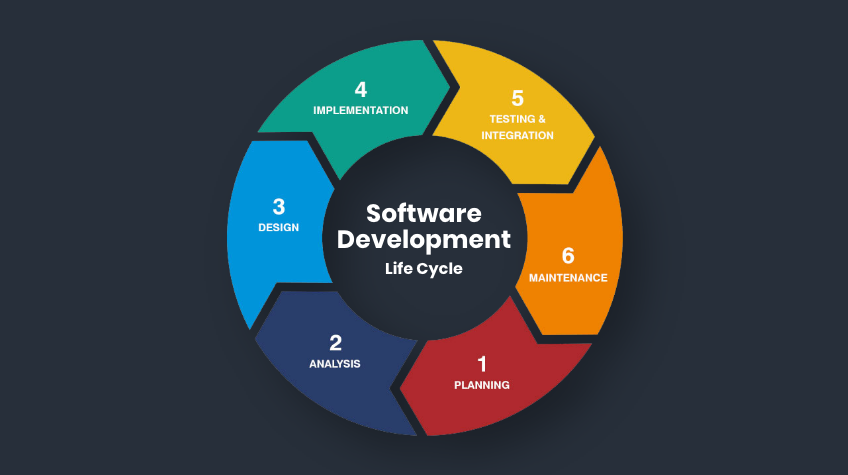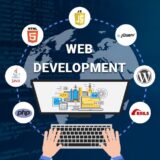Software Development Life Cycle (SDLC) and It Important
The Software Development Life Cycle (SDLC) is a systematic approach used by software development teams to design, develop, test, deploy, and maintain high-quality software products. It provides a structured framework that guides the entire software development process, ensuring efficiency, effectiveness, and successful project outcomes. The SDLC consists of various phases, each with its own set of activities and deliverables, enabling organizations to manage the entire software development process in a well-defined and systematic manner. In this article, we will explore the significance of the SDLC in software development, its importance, benefits, challenges, and best practices for successful implementation. We will also delve into the comparison between agile and waterfall approaches to help you choose the right SDLC model for your projects. Understand the importance of following a structured approach to ensure efficient and successful software development projects.
What is the SDLC?
Software Development Life Cycle (SDLC) is like the roadmap for building a software product – it outlines all the necessary steps from start to finish. Think of it as a recipe for creating software, but with less flour and way more code.
Evolution of the SDLC
The SDLC has come a long way since its inception. Back in the day, software development was like a wild west show – everyone did their own thing, and chaos reigned supreme. But as the demand for more structured and reliable software grew, so did the need for a standardized process. And thus, the SDLC was born, bringing order and sanity to the software development world. Bless its little code-loving heart.

2. Phases of the Software Development Life Cycle
Requirements Gathering and Analysis
This phase is like going on a first date with your client – you ask a million questions, take notes, and try to understand their hopes, dreams, and every single little detail they want in their software. Basically, you’re their software therapist, extracting their requirements and analyzing them like a pro.
System Design
Once you’ve gathered all the juicy details from your client, it’s time to put your creative hat on and design the system architecture. This is where you lay the foundation for your software, like a really cool architect but with less concrete and more lines of code.
Coding and Implementation
Ah, the coding phase – the heart and soul of software development. Here, you transform your beautifully designed plans into actual working software. It’s like magic, but with more coffee and late-night coding sessions.
Testing and Quality Assurance
Testing is like holding a magnifying glass over your code and meticulously checking for any little bugs or defects that might be hiding. This phase ensures that your software works as intended and doesn’t do anything crazy, like turning people’s laptops into sentient beings.
Deployment and Release
It’s time to release your software into the wild and let it spread its proverbial wings. This phase involves carefully deploying your code and making sure it works smoothly in the production environment. It’s like sending your kid off to college – you hope they thrive, make good choices, and don’t embarrass themselves too much.
Maintenance and Support
Just like taking care of a pet or doing your taxes, software requires ongoing maintenance and support. This phase involves fixing any bugs, making updates, and providing technical assistance to keep your software running smoothly. It’s like being a software superhero, swooping in to save the day whenever something goes wrong.
3. Importance of the SDLC in Software Development
Ensuring Efficiency and Effectiveness
The SDLC keeps you on track and helps you build software efficiently. It’s like having a GPS for your development process, guiding you to your destination without getting lost in the code wilderness.
Minimizing Errors and Defects
By following a structured process and thoroughly testing your software, the SDLC helps you catch those sneaky bugs before they cause chaos and make your users want to throw their computers out the window. We don’t want that, do we?
Managing Project Scope and Budget
Ever had a project run way over budget and way past its deadline? Yeah, not fun. The SDLC helps you keep the project’s scope in check and prevents you from going down a rabbit hole of endless features and never-ending development. Budget control is key, my friend.
Meeting Stakeholder Expectations
Nothing brings a smile to a stakeholder’s face like delivering a software product that fulfills their wildest dreams (software-related dreams, that is). The SDLC ensures that you’re constantly communicating and collaborating with your stakeholders, ensuring that everyone is on the same page and happy with the end result.

4. Benefits of Following the SDLC
Improved Project Management
With the SDLC, you have a clear roadmap and a well-defined process, making project management a breeze (well, compared to herding cats, anyway). It helps you keep track of tasks, milestones, and deadlines, ensuring that your project stays on track and your stress levels don’t skyrocket.
Enhanced Collaboration and Communication
The SDLC encourages collaboration and communication between team members, stakeholders, and even your cat who likes to sit on your keyboard. It helps everyone stay in sync, share ideas, and work towards the common goal of creating awesome software. Meow-tactic!
Higher Quality Software Products
By following a structured process, thoroughly testing, and focusing on quality assurance, the SDLC helps you deliver software that’s as reliable as your favorite pair of jeans (you know, the ones that never let you down). High-quality software equals happy users and fewer support calls. Win-win.
Reduced Development Costs
Nobody likes spending more money than necessary, right? The SDLC helps you manage your resources efficiently, identify potential risks early on, and avoid costly mistakes. It’s like having a personal financial advisor for your software project – you’re saving money and feeling all financially responsible. Go you!
And that, my software-loving friend, is the lowdown on the Software Development Life Cycle (SDLC) – from its inception to its oh-so-important role in software development. Now go forth and create awesome software with confidence, knowing that the SDLC is there to guide you like a trusty companion.
5. Challenges and Risks in the SDLC
Changing Requirements and Scope Creep
One of the biggest challenges in the software development life cycle (SDLC) is dealing with changing requirements and scope creep. It’s like trying to hit a moving target that keeps getting farther away. Just when you think you’ve got everything figured out, the client comes back with a laundry list of new features they want or changes they’d like to see. It can be frustrating, but it’s important to be flexible and adaptable in order to meet the evolving needs of the project.
Resource Allocation and Time Constraints
Another challenge in the SDLC is resource allocation and time constraints. You’re given a limited number of people, a fixed budget, and a tight deadline. It’s like trying to make a gourmet meal with just a toaster oven and a handful of ingredients. You have to make the most of what you have and find creative solutions to get things done on time and within budget.
Technical and Compatibility Issues
Technical and compatibility issues are also common risks in the SDLC. It’s like trying to put together a jigsaw puzzle when some of the pieces are from a completely different puzzle. You may encounter hardware or software limitations, integration challenges, or compatibility issues that can slow down the development process or even bring it to a halt. It’s important to have a solid understanding of the technical landscape and to plan ahead for potential roadblocks.
Poor Communication and Coordination
Lastly, poor communication and coordination can wreak havoc on the SDLC. It’s like trying to build a skyscraper without a blueprint or a construction crew that speaks different languages. Misunderstandings, lack of collaboration, and poor communication between team members can lead to delays, errors, and a lot of frustration. Effective communication and coordination are key to keeping everyone on the same page and moving in the right direction.

6. Best Practices for Implementing the SDLC
Establishing Clear Requirements and Goals
When implementing the SDLC, it’s crucial to establish clear requirements and goals from the start. It’s like setting the GPS coordinates before embarking on a road trip. Without a clear destination in mind, you’ll just be driving aimlessly. By clearly defining what you want to achieve and what the software needs to do, you can avoid unnecessary detours and stay focused on delivering a successful product.
Adopting Agile and Iterative Approaches
Agile development has become increasingly popular in the SDLC, and for good reason. It’s like taking small steps instead of trying to leap across a canyon. By breaking the development process into smaller, manageable iterations, you can quickly gather feedback, make adjustments, and adapt to changing requirements. This helps to reduce risks, improve collaboration, and deliver a higher quality product.
Conducting Regular Testing and Quality Control
Testing and quality control are essential parts of the SDLC. It’s like taste-testing your cooking along the way to ensure it’s turning out delicious. Regularly testing the software throughout the development process allows you to identify and fix issues early on, ensuring that the final product meets the necessary quality standards. This helps to minimize surprises and ensures a smoother transition to the next phase of development.
Documenting and Tracking Progress
Documenting and tracking progress is like keeping a journal of your software development journey. It allows you to look back and see how far you’ve come and helps you stay organized and focused on the tasks at hand. By keeping thorough documentation, you can easily reference previous decisions, track changes, and identify any potential bottlenecks or areas for improvement. It’s like having a roadmap to guide you through the SDLC.
7. Agile vs Waterfall: Choosing the Right SDLC Approach
Understanding Waterfall Methodology
The Waterfall methodology is like following a strict recipe from start to finish. It involves a linear and sequential approach, where each phase of the SDLC is completed before moving on to the next. This can be suitable for projects with stable and well-defined requirements, where changes are unlikely to occur. It provides a clear structure and timeline, making it easier to plan and estimate costs. However, it can be less flexible when it comes to accommodating changes or responding to feedback.
Exploring Agile Development
Agile development, on the other hand, is like cooking without a recipe and adjusting ingredients to taste as you go. It emphasizes adaptability, collaboration, and continuous improvement. Agile projects are divided into short iterations, known as sprints, allowing for regular feedback and adjustments. This approach is beneficial for projects with changing requirements, complex features, or a need for frequent customer involvement. It enables teams to respond quickly to changes and deliver incremental value throughout the development process.
Choosing the right SDLC approach ultimately depends on the specific project requirements, resources, and client expectations. It’s like deciding whether to follow a recipe or improvise in the kitchen. Both methodologies have their pros and cons, and it’s important to consider the unique needs of each project before making a decision.
In conclusion, the Software Development Life Cycle (SDLC) plays a crucial role in ensuring the successful development and delivery of high-quality software products. By following the various phases of the SDLC, organizations can effectively manage projects, meet stakeholder expectations, minimize errors, and control costs. While there may be challenges and risks associated with the SDLC, adopting best practices such as clear requirements gathering, regular testing, and documentation can mitigate these issues. Additionally, understanding the differences between agile and waterfall approaches can help teams select the most suitable SDLC model for their specific projects. Embracing the SDLC as a guiding framework empowers software development teams to streamline processes, enhance collaboration, and deliver exceptional software solutions.
FAQ
1. What are the main phases of the Software Development Life Cycle (SDLC)?
The main phases of the SDLC include requirements gathering and analysis, system design, coding and implementation, testing and quality assurance, deployment and release, and maintenance and support. Each phase has its own set of activities and deliverables, ensuring a systematic and structured approach to software development.
2. Why is the SDLC important in software development?
The SDLC is important in software development as it provides a structured framework for managing projects. It ensures efficiency and effectiveness, minimizes errors and defects, helps manage project scope and budget, and ultimately meets stakeholder expectations. By following the SDLC, organizations can deliver high-quality software products that are on time and within budget.
3. What are the benefits of following the SDLC?
Following the SDLC brings several benefits to software development projects. It improves project management by providing a clear roadmap and structure. It enhances collaboration and communication among team members and stakeholders. The SDLC also leads to higher quality software products, as it includes testing and quality assurance phases. Additionally, following the SDLC can help reduce development costs and prevent rework.
4. How does the choice between agile and waterfall approaches impact the SDLC?
The choice between agile and waterfall approaches impacts the SDLC by determining the overall project management and development methodology. Waterfall follows a linear sequential process, while agile emphasizes iterative development and adaptability. The choice depends on factors such as project complexity, requirements volatility, and stakeholder involvement. Understanding the differences between these approaches helps in selecting the appropriate SDLC model for a given project.
Thank you for reading 🙂
If you want to build your website in an affordable price contact: www.nextr.in
Read this: How To Become A Software Engineer/Developer In 2023

















